Don’t let pH scare you! If science wasn’t your favorite subject in school, it might immediately send shivers down your spine. However, for your aquarium there is no need to worry.
My main messages to you are that regular pH testing is a good thing and that you want to keep your tank’s pH stable. But as always, it’s good to understand a little more of the reasons behind the advice.
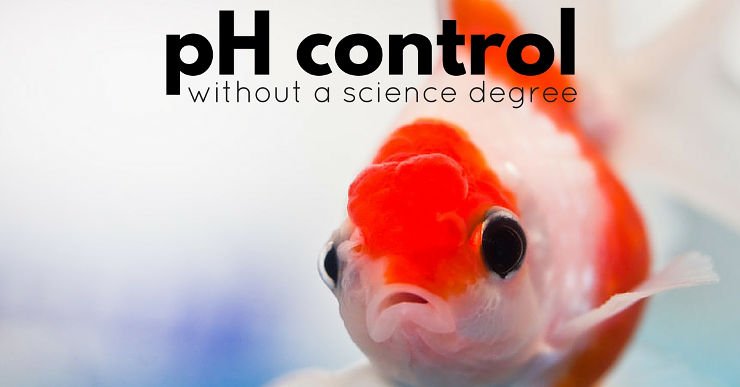
(source)
pH is a characteristic of your water. It is a measure of the concentration of hydrogen ions, but please don’t turn off! It is not much different from any other characteristic…….
For example, saltiness…. We understand naturally that marine fish need salt and freshwater fish don’t and so we make sure the amount of salt in our aquarium water matches the fish we keep.
NavigationThe “Science” bitpH tidbitsHow pH affects your fishEnsuring you have pH control: How to measure pHMake life easy for yourselfNow pick your pHishAdjusting pHHow to lower the pH of your water (making it more acidic)How to raise the pH of your water (making it more alkaline)Hardcore pH changeClosing Thoughts
It is the same for pH. Our fish will like water which is similar to that they would live in if they were in the wild. So, research your fish and you will discover the pH they come from, also look for notes on whether they are particularly sensitive to pH. Nowadays, many fish have been tank-bred, these are likely to be more tolerant of different water chemistry than their wild relatives.
In an ideal world, it would be great if you could make the tank pH close to that the fish would have experienced in nature. However, fish are adaptable and you may find that if you acclimate your fish slowly you can get them to do fine in a pH that is some way off what the books say is ideal. Research your fish to see if they have very specific needs.
The “Science” bit
pH levels are given as a number, normally between 0 and 14. The lower the pH number is, the more acidic the liquid is. So, for example, battery acid has a pH of 1 Not even Discus like that! At the opposite end of the scale, you would find domestic bleach which has a pH of 13. The exact middle of the scale (pH 7) is ‘neutral’.

pH scale (source)
Now, not all freshwater is neutral but you will never see super high or low pHs when you are looking up your fishes’ need. Aquatic life likes the middle ground, near neutrality. Almost any fish you bump into will come from an environment where the pH is between pH5.5 and pH8.5.
You’re maybe thinking… why bother then? My water is pH6 but my fish like pH8. They sound pretty similar, it’s only two out. Right?
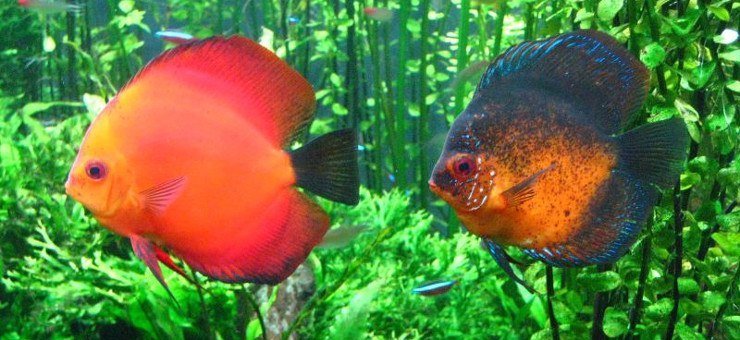
Discus (source)
One last science bit. Buffers. Buffers are chemicals that help your pH stay stable. They mop up acid and alkali to push things back towards balance. Buffering is an aquarists friend as it helps stop big pH swings that might damage your fish.
You can buy buffers to add to your tank water which helps keep it in a particular pH range. Most people manage without them but they might be worth considering if you have erratic pH readings.
pH tidbits
- pH and softness are not the same, but they are kind of related. In aquariums there are many species that like the soft/acid or hard/alkali combos as those are what often occur in nature.
- Hard water naturally has minerals in it that help buffer the water. Since soft water tanks have less of these minerals pH swings are more of a risk.
- Higher pH makes pollution from fish waste more deadly, but on the other hand it helps your filter bacteria work efficiently. Either way if you keep your water clean the fish will be happier.
- Your tank will get more acidic if you do infrequent water changes. But this is not a good way to lower your pH! If your pH is steadily dropping for no obvious reason, change some water.
How pH affects your fish
A wildly wrong or wildly swinging pH can kill fish. It makes it hard for them to control the amount of water in their bodies. Imagine being really over-hydrated or dehydrated. Rapid change is worse. There are times when these kind of fast pH changes are predictable and you can plan to prevent or minimize their effects.
One potential danger point is when you introduce new fish to your tank. The water in the pet store may be quite different from yours. It is important to acclimate your fish gently before adding them to the tank. This is a great link for the way to do this.
Another situation in which a big pH swing can happen is when you do water changes. Water changes are a great thing for your fish but you need to make sure the new water is similar to that already in your aquarium (except cleaner!). This is much easier if your tap water is close to the same pH as that in your tank. If you are aware of a difference, do several smaller water changes.
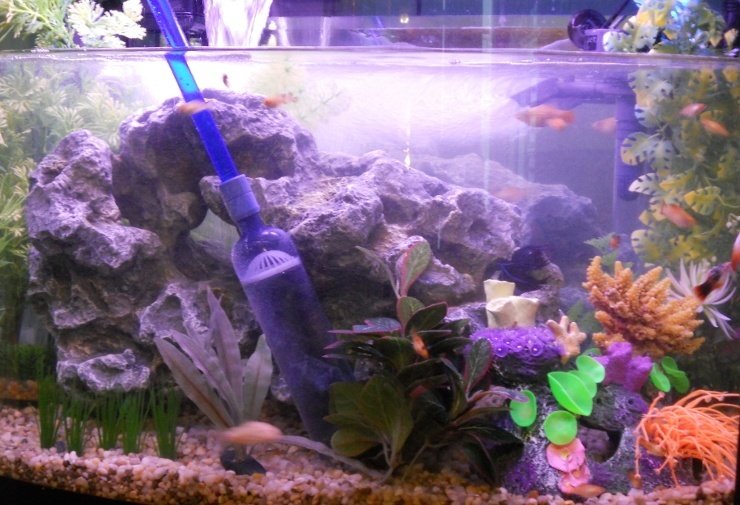
Water changes (source)
Ensuring you have pH control: How to measure pH
pH is important then, but the thing to remember is that you can manage it. Just like keeping the temperature of your tank right, you can do things that will keep your fish pH-happy.
Rather like maintaining the right tank temperature, you stand a better chance of keeping pH in your chosen range if you check the level often. You can check the pH of your water in a variety of ways:
- pH test strips: quick and easy,
- pH liquid test kit: accurate but fussy,
- pH meter: super accurate, but need calibrating occasionally.
I find the easiest thing is using the test strips and I favor ones that test other things at the same time. I check my tanks’ pH at least once a week to make sure things are running smoothly.
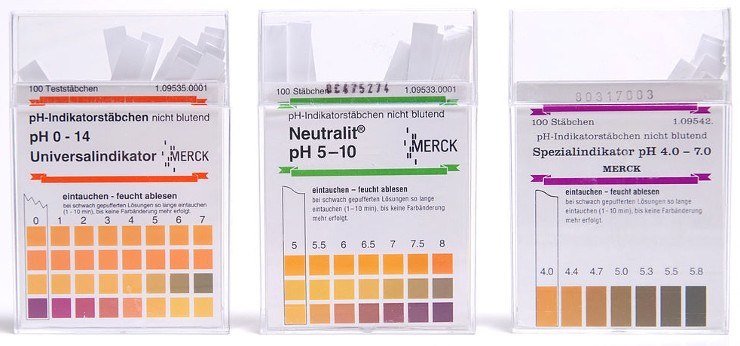
pH strips – Different range (source)
You don’t need to panic if your pH drifts a little. Fish can cope with moderate and slow changes. Try and keep your pH within 0.5 of what you think is a good middle ground and make sure any change is gradual.
So, have a target pH range in your mind, not an exact figure. You will be fighting a losing battle if you decide that your fish need exactly pH7.0 (for example) and make changes to your routine every time it changes. Instead, say to yourself that you are going to aim to keep the water between pH6.7 and 7.2. You then only need to think of taking action if your water tests show it is pushing out of this range at either end.
More aquarium test kits details on a separate article.
Make life easy for yourself
In a minute I’m going to be talking about how to adjust and control your water’s pH. However, unless you have some specific requirements there a few choices you can make that just cut out a lot of the difficulties.
- Don’t fight your water supplier. Try choosing fish that like the pH of your tap water. This will save you the trouble of having to adjust it. You just have to maintain it. Test your tap water.
- Choose tank décor carefully. Some rock/gravel will shift your pH level. I’ll cover this later but many rocks and substrate (particularly limestones and coral based sands and gravels) make your water less acidic and bogwood makes it more acidic. Choose the materials that won’t fight the pH you need. Ask your supplier for advice.
- Don’t inject CO2. Carbon dioxide makes your water more acidic. It’s not a big deal but if you have a planted tank and do inject, pH will need monitoring more carefully.
Now pick your pHish
Sorry, lousy pun, but the fish you want helps to decide what pH you are aiming for. First off, you should choose fish that are all happy within a similar pH range. You can’t have an acid end and alkali end!
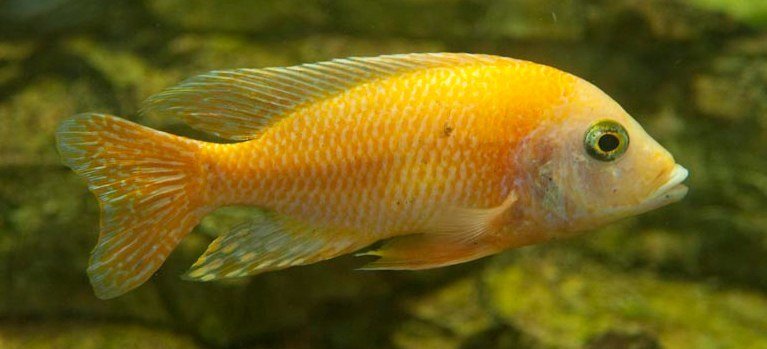
Lake Malawi Cichlid (source)
I made this mistake recently. I went all out setting up a new tank which was quite acidic. This was perfect for the fish I had chosen but then I added snails that would have been happier with it neutral to alkaline. Now I had to rehome them or worry they will fade away and die.
Fortunately, if you choose a pH range around 7 you can choose from hundreds of species. This near-neutral water range is really the best choice if you want a community tank of tropical fish, it is fairly easy to maintain and it gives you the biggest choice of inhabitants.
The pH some fish are used to in nature:
- Super Alkali Fish (pH 7.5 and up): Lake Malawi and Taganyikan Cichlids.
- Neutral to Slightly Alkali Fish (pH 7.0-7.5): Goldfish (not tropical!), Livebearers.
- Neutral to Acid Fish (pH 6.5-7.0): Most Tetras, Angels, Corydoras, Apistos.
- Super Acid Fish (pH 6.5 and below): Discus, Cardinal Tetras.
Adjusting pH
It is possible to buy chemical additives to change the pH of your water. But if you choose this route it will take you time and money and a lot of water testing. An easier way to go is to nudge your tank in the direction you want it to go. It is safer to use a natural approach as you are less likely to overshoot your changes.
How to lower the pH of your water (making it more acidic)
All these things will help to decrease the pH in your aquarium.
- Peat moss in your filter
- Driftwood
- Catappa leaves
- No limestone rocks
- No coral sand
Peat moss, driftwood, and Catappa leaves all work by releasing substances called tannins. This chemical will soften as well as acidify your water. It works by binding up carbonates in the water. The degree of softening and acidity you get depends on how much of these materials you add.
All three will also tint your water brown. Not everyone likes this, although it probably doesn’t bother the fish. You will read elsewhere that you can remove this side effect with activated carbon or a resin like Purigen. You can, but my guess is that it might also remove a lot of the acidifying effects too. I find, in my tank, that regular water changes stop the color from ever building up to a problem level.
Peat
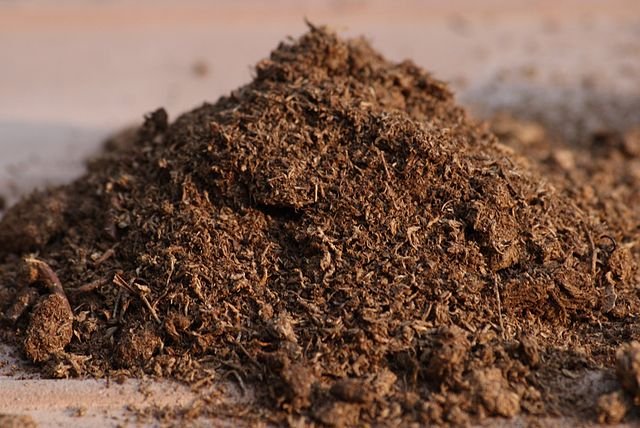
Peat Moss (source)
As the water flows through the peat, tannins leach out. It is important to get a pure source of peat moss that you trust, I would buy it from a reputable aquarium hobby company. Add less than you think is necessary to start with and check your pH more regularly to see that you don’t overdo it.
Another option is to soften the water before you add it to your tank, this gives you more control as you can test the pH before pouring into your tank.
Driftwood / Bogwood / Mopani Wood
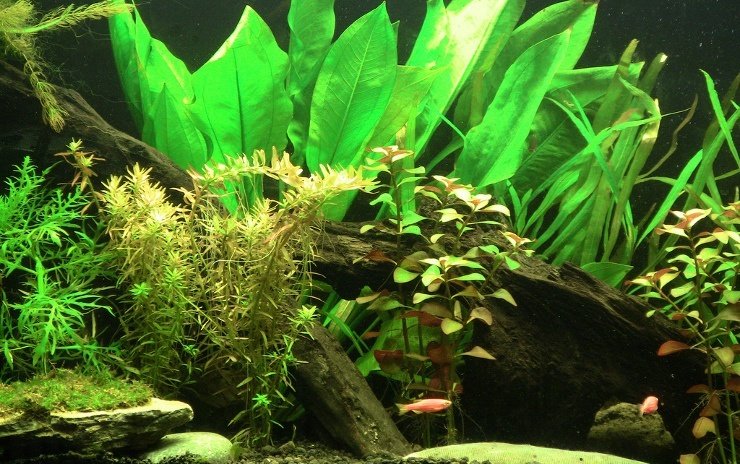
Driftwood and Amazon Sword (source)
A lot of different woods are sold in the aquarium trade. There is much advice on how boiling them or soaking them for weeks will reduce the effect they have on water color. I have found these to have limited effect, that said, I would still soak new pieces in boiling water to sterilize them before they go into your tank.
- Driftwood – has come to mean pretty much any dried wood. Pieces will need soaking or they will float, you can pin them down with rockwork.
- Bogwood – proper bogwood is old wood that has been submerged in water for years in conditions with little oxygen. It tends to be dense and easier to get to sink. In my experience, it is the richest wood for tannin and color release.
- Mopani Wood – This is the wood from an African tree, it is naturally very dense and heavy and so, in theory, takes less effort to soak to a stage whereby it will sink.

Catappa leaves (source)
Catappa leaves are pretty fashionable in the aquarium hobby at the moment. There are multiple claims out there about their anti-fungal and even anti-bacterial properties. They are purchased dried and take a day or so of floating before they sink. I have bought them from 3-12 inches in length.
Catappa leaves work to make water acidic in the same way as bogwood and peat. They are particularly useful in nano tanks and for shrimp setups.
How to raise the pH of your water (making it more alkaline)
- Frequent water changes
- Good filtration
- Limestone
- Coral sands and gravels
- Shells
- Do not add a lot of wood décor
This is an easier proposition than making water acidic. Limestone, corals, and shells all release carbonates slowly into your water. The carbonates mop up spare hydrogen ions. The result is hard, alkaline water. The pH is increased.
You can add these elements as substrate (gravel or sand), decoration (limestone rockwork or whole shells) or in media bags in your filter in the form of limestone chips, crushed coral or oyster shell.
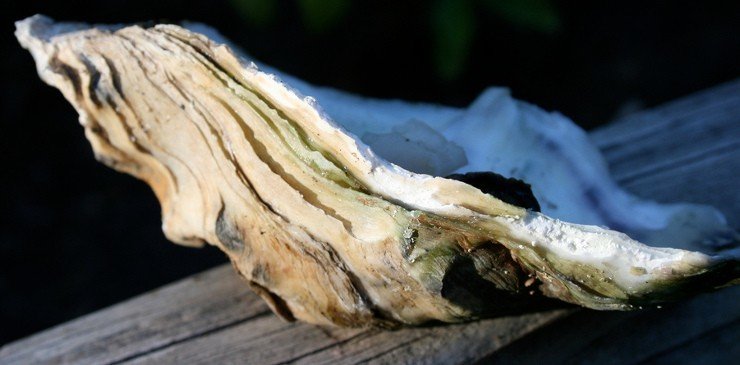
Oyster shell striations (source)
Hardcore pH change
If you plan to set up a tank for fish that need a pH that is very specific one way or the other, a reliable but expensive way to do it is to buy or make your own reverse osmosis water and then add back the elements you need to produce your perfect water.
There are all kinds of mineral mixes out there to help you do this but it is beyond the scope of this article.
Closing Thoughts
In preparing this article I bumped into something I hadn’t really expected, stories of people who did more harm than good chasing an ‘ideal’ pH for their fish. For most hobbyists, the real story on pH is that keeping it stable, measuring it regularly and acclimating new fish slowly are the important issues.
There are cases when you want to change your pH but mostly you can do this by gently nudging the water chemistry in the right direction by the natural methods I have described here. Do remember, though, you are not just changing the pH of the tank but signing up to change the pH of any water you add to the tank in future.
As always, please give me feedback on what I have written and tell me more about your experiences with managing pH in your tanks. It is such a help to know what articles you like and to be able to include your real life aquarium experiences in our pages.

